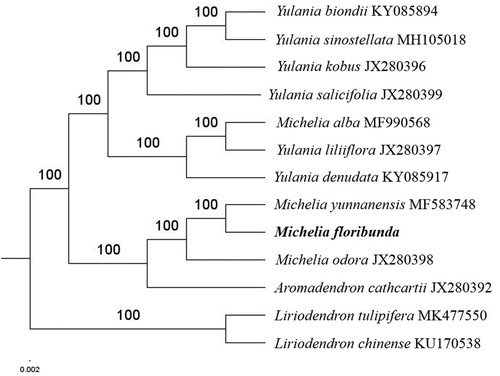Abstract
The first complete chloroplast genome (cpDNA) sequence of Michelia floribunda was determined from Illumina HiSeq pair-end sequencing data in this study. The cpDNA is 160,049 bp in length, contains a large single-copy region (LSC) of 88,140 bp and a small single-copy region (SSC) of 18,773 bp, which were separated by a pair of inverted repeats (IR) regions of 26,568 bp. The genome contains 132 genes, including 87 protein-coding genes, 8 ribosomal RNA genes, and 37 transfer RNA genes. Further phylogenomic analysis showed that M. floribunda was closely related to Michelia yunnanensis in Michelieae tribe.
Michelia floribunda is the species of the genus Michelia within the family Magnoliaceae, native in Yunnan, Sichuan, Hubei of China and Myanmar. It is an excellent timber and ornamental plant (Zhu et al. Citation2012). The leaves of M. floribunda have rich content of sesquiterpene lactones (Xiong et al. Citation2001). The extract of M. floribunda also showed antibacterial and anticancer activities (Zhao Citation2005). The pyrethroid from M. floribunda has insecticidal activity (Mondranondra et al. Citation1990). However, there has been no genomic studies on M. floribunda.
Herein, we reported and characterized the complete M. floribunda plastid genome. The GenBank accession number is MN897728. One M. floribunda individual was collected from Kunming arboretum, Yunnan Academy of Forestry, Yunnan Province of China (25°14′48ʺN, 102°75′53ʺE). The specimen is stored at Yunnan Academy of Forestry Herbarium, Kunming, China, and the accession number is S97156. DNA was extracted from its fresh leaves using DNA Plantzol Reagent (Invitrogen, Carlsbad, CA, USA).
Paired-end reads were sequenced using Illumina HiSeq system (Illumina, San Diego, CA). In total, about 8.8 million high-quality clean reads were generated with adaptors trimmed. Aligning, assembly, and annotation were conducted by CLC de novo assembler (CLC Bio, Aarhus, Denmark), BLAST, GeSeq (Tillich et al. Citation2017), and GENEIOUS v 11.0.5 (Biomatters Ltd, Auckland, New Zealand). To confirm the phylogenetic position of M. floribunda, other 10 species of Michelieae tribe from NCBI were aligned using MAFFT v.7 (Katoh and Standley Citation2013). The auto-algorithm in the MAFFT alignment software was used to align the 13 complete genome sequences and the G-INS-i algorithm was used to align the partial complex sequences. The maximum likelihood (ML) bootstrap analysis was conducted using RAxML (Stamatakis Citation2006); bootstrap probability values were calculated from 1000 replicates. Liriodendron tulipifera (MK477550) and Liriodendron chinense (KU170538) were served as the out-group.
The complete M. floribunda plastid genome is a circular DNA molecule with the length of 160,049 bp, contains a large single-copy region (LSC) of 88,140 bp and a small single-copy region (SSC) of 18,773 bp, which were separated by a pair of inverted repeats (IR) regions of 26,568 bp. The overall GC content of the whole genome is 39.2%, and the corresponding values of the LSC, SSC, and IR regions are 37.9%, 34.3%, and 43.2%, respectively. The plastid genome contained 132 genes, including 87 protein-coding genes, 8 ribosomal RNA genes, and 37 transfer RNA genes. Phylogenetic analysis showed that M. floribunda was closely related to Michelia yunnanensis in Michelieae tribe (). The determination of the complete plastid genome sequences provided new molecular data to illuminate the Michelieae tribe in Magnoliaceae family evolution.
Disclosure statement
No potential conflict of interest was reported by the author(s).
Additional information
Funding
References
- Katoh K, Standley DM. 2013. MAFFT multiple sequence alignment software version 7: improvements in performance and usability. Mol Biol Evol. 30(4):772–780.
- Mondranondra O, Che CT, Rimando AM, Vajrodaya S, Fong HH, Farnsworth NR. 1990. Sesquiterpene lactones and other constituents from a cytotoxic extract of Michelia floribunda. Pharm Res. 07(12):1269–1272.
- Stamatakis A. 2006. RAxML-VI-HPC: maximum likelihood-based phylogenetic analyses with thousands of taxa and mixed models. Bioinformatics. 22(21):2688–2690.
- Tillich M, Lehwark P, Pellizzer T, Ulbricht-Jones ES, Fischer A, Bock R, Greiner S. 2017. GeSeq-versatile and accurate annotation of organelle genomes. Nucleic Acids Res. 45(W1):W6–W11.
- Xiong J, Dai HF, Yi YF, Yu Z, Zhou J. 2001. Voltile components of the leaves of Michelia floribunda. Nat Prod Res Dev. 13(5):13–14.
- Zhao LQ. 2005. Advanced research on terpenoids in Michelia and their biological activity. Lishizhen Med Mater Med Res. 16(8):722–724.
- Zhu YF, Hao JB, Sima YK, Xu L, Han MY, Ma HF. 2012. Floral numerical variation of Michelia floribunda. J West China for Sci. 41(6):58–62.

